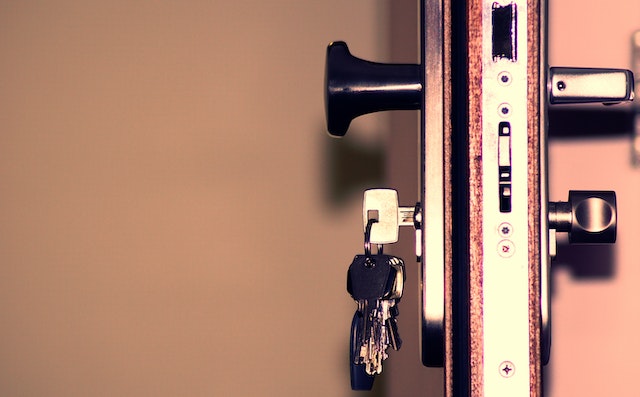
How does a skeleton key work? By removing all of the parts that would get caught on the wards.
Skeleton keys are also known as pass keys or master keys. They are called “skeleton keys” because all of the main parts of the key have been stripped off and only the skeleton is left.
People have been using locks for over 6000 years, but they were fairly simple. Modern locks became possible after the Industrial Revolution introduced precision engineering and standardized components. A modern key and lock can only work if all of the pieces have been machined to perfect and exact specifications. There were a few jumps in the evolution of the lock, but the lock we use today was invented in 1848.
There are many types of lock, but the two main types of lock that we use today are warded locks and pin tumbler locks. The skeleton key for each type of lock works in a slightly different way.
Warded locks were invented in ancient China and Rome. Most locks on old buildings were warded locks. They have been improved for security, but are still not as good as other types of lock. People generally use warded locks on places that don’t need to be locked very securely. A warded lock works by having wards, which are obstructions fitted inside the lock. The obstructions are welded inside the lock and the key has to be the correct shape to fit over all of the obstructions and turn the lock. If the key is incorrect, it will jam against the obstructions and won’t be able to turn.
A skeleton key for a warded lock works by removing all of the parts of the key that would jam against the wards. The key is left with the shank (the long bit) and the bits (the parts that engage the lock). The sections that interact with the wards are removed. The skeleton key can be inserted and it turns freely because there is no metal to come up against the wards. All locks were different sizes, so it would be necessary to know the size of the key, but, in theory, an easy skeleton key for every warded lock could be made. This was a huge security flaw with the lock and is why they aren’t used for important things these days.
Pin tumbler locks are the second type of lock. They are far more secure than warded locks. They were invented in Egypt in about 2000 BC, but they have become a lot more secure. A pin lock has multiple pins that rest on top of the lock mechanism. The pins prevent the lock from turning and they have to be lifted so the lock can move. In the earliest forms of the lock, each pin was a single piece of metal and all the pins had to be lifted to a uniform height, which meant that any piece of metal could open the lock. In 1805, a double-acting pin lock was invented. In this lock, each pin has a second pin resting on top of it and they are pressed down by a spring. The pins have to be raised to an exact height so that the bottom pin will turn with the tumbler. If the pin is too low, the tumbler will hit the top pin and stop. If the pin is too high, the tumbler will hit the bottom pin and stop. If the height is perfect, the tumbler will rotate. Each of the pins has a different set height which corresponds to the shape of the key.
So, how does a skeleton key work with a pin tumbler lock? A lot of offices and apartment blocks use pin tumbler locks. The resident of each apartment and office needs their own key that only opens their office or apartment. However, the people in charge of the office or the apartment need to be able to access all the rooms. To do this, they need a master key, or a skeleton key. This is possible because locks that are designed to be opened with both a master and a regular key have three sets of pins instead of two. The bottom pin and the middle pin work in exactly the same way as a regular tumbler lock. Each pin has to be lifted to a certain height so they will rotate, and each lock is unique. The top set of pins is where the magic happens. The top pin and the middle pin are also set to a specific height, but this height is the same on every lock designed to be opened by the master key. So, your key will open your room, but if you try it on your neighbor’s, the pins won’t lift properly and it won’t open. When the landlord uses his master key on your lock, it lifts the pins all the way to the third set and allows the lock to open. He can do the same on your neighbor’s because the third set of pins are exactly the same.
So, how does a skeleton key work? Depending on the lock, it either bypasses the mechanism or the lock has a mechanism specifically for the master key. And this is what I learned today.
Sources
https://en.wikipedia.org/wiki/Skeleton_key
https://en.wikipedia.org/wiki/Warded_lock
https://en.wikipedia.org/wiki/Pin_tumbler_lock
https://www.aboutmechanics.com/what-is-a-skeleton-key.htm
https://www.grainger.com/know-how/equipment-information/kh-types-of-door-locks
